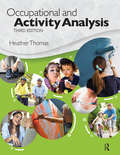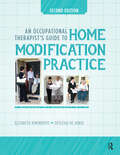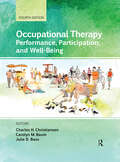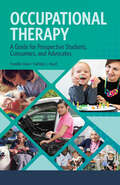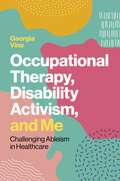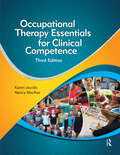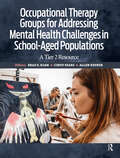- Table View
- List View
Occupational and Activity Analysis
by Heather ThomasNewly updated to reflect the Occupational Therapy Practice Framework: Domain and Process, Fourth Edition (OTPF-4), Occupational and Activity Analysis, Third Edition outlines the process of conducting occupational and activity analyses for occupational therapy students and clinicians.Occupational therapy practitioners use occupations and activities not only as a goal but also as a treatment medium, so understanding both the uniqueness of a client’s occupations and how an activity can be used therapeutically is essential. This text is an introduction to both realms, first by explaining the process by which to peel back the layers of an occupation or activity to reveal its intricacy and then examining how to use this information for evaluation and intervention.Dr. Heather Thomas has updated Occupational and Activity Analysis, Third Edition to reflect the significant changes made to the activity analysis process and terminology in the OTPF-4. Conducting either an occupational or activity analysis investigates not only what is required for full participation but also looks at the meaning ascribed to it by the people, groups, or communities engaging in it and how personal and environmental contexts impact participation.What’s new and included in the Third Edition: Chapters throughout the text have been updated to reflect the changes in the OTPF-4. Updated educational standards set by the Accreditation Council for Occupational Therapy Education (ACOTE) for doctoral and master’s level and occupational therapy assistant programs. Additional cases and relevant clinical examples. Updated tables, boxes, and figures throughout. Expanded section on communication management. Appendices containing updated occupational and activity analysis forms. Example of a full activity analysis. Updated and added photos to help students understand concepts. Included with the text are online supplemental materials for faculty use in the classroom.As a foundational skill, occupational and activity analysis is utilized throughout students’ careers and into their lives as practitioners, making Occupational and Activity Analysis, Third Edition the perfect textbook for the occupational therapy or occupational therapy assistant student, faculty, or clinician.
An Occupational Perspective of Health
by Clare Hocking Ann WilcockFor nearly 20 years, An Occupational Perspective of Health has been a valuable text for health practitioners with an interest in the impact of what people do throughout their lives. Now available in an updated and much-anticipated Third Edition, this unique text continues the intention of the original publication: it encourages wide-ranging recognition of occupation as a major contributor to all people’s experience of health or illness. It also promotes understanding of how, throughout the world, “population health” as well as individual well-being is dependent on occupation. At international and national levels, the role of occupation in terms of the physical, mental, and social health of all individuals and populations remains poorly understood and largely overlooked as an inevitable and constant factor. An Occupational Perspective of Health, Third Edition by Drs. Ann Wilcock and Clare Hocking, in line with directives from the World Health Organization (WHO), encourages practitioners of public health, occupational therapy and others to extend current thinking and practice and embrace a holistic view of how occupation and health interact.Addressed in the Third Edition: An explanation of how individual and population health throughout the world is impacted by all that people do A drawing together of WHO ideas that relate to health through occupation, and how people individually and collectively feel about, relate to others, and grow or diminish through what they do A multidisciplinary orientation to promote health and reduce illness by increasing awareness and understanding of the impact of occupations across sleep-wake continuums throughout lifespans and communities The connection of health and occupation is held to be fundamental, although ideas about both have altered throughout time as environments and cultures have evolved. To improve interdisciplinary understanding, An Occupational Perspective of Health, Third Edition explains the concepts of attaining, maintaining, or reclaiming population health through occupation. Instructors in educational settings can visit www.efacultylounge.com for additional materials to be used for teaching in the classroom. Practitioners and students of occupational therapy, health sciences, and public or population health will benefit from and relate to An Occupational Perspective of Health, Third Edition.
An Occupational Perspective of Health
by Clare Hocking Ann WilcockFor nearly 20 years, An Occupational Perspective of Health has been a valuable text for health practitioners with an interest in the impact of what people do throughout their lives. Now available in an updated and much-anticipated Third Edition, this unique text continues the intention of the original publication: it encourages wide-ranging recognition of occupation as a major contributor to all people’s experience of health or illness. It also promotes understanding of how, throughout the world, “population health” as well as individual well-being is dependent on occupation. At international and national levels, the role of occupation in terms of the physical, mental, and social health of all individuals and populations remains poorly understood and largely overlooked as an inevitable and constant factor. An Occupational Perspective of Health, Third Edition by Drs. Ann Wilcock and Clare Hocking, in line with directives from the World Health Organization (WHO), encourages practitioners of public health, occupational therapy and others to extend current thinking and practice and embrace a holistic view of how occupation and health interact.Addressed in the Third Edition: An explanation of how individual and population health throughout the world is impacted by all that people do A drawing together of WHO ideas that relate to health through occupation, and how people individually and collectively feel about, relate to others, and grow or diminish through what they do A multidisciplinary orientation to promote health and reduce illness by increasing awareness and understanding of the impact of occupations across sleep-wake continuums throughout lifespans and communities The connection of health and occupation is held to be fundamental, although ideas about both have altered throughout time as environments and cultures have evolved. To improve interdisciplinary understanding, An Occupational Perspective of Health, Third Edition explains the concepts of attaining, maintaining, or reclaiming population health through occupation. Instructors in educational settings can visit www.efacultylounge.com for additional materials to be used for teaching in the classroom. Practitioners and students of occupational therapy, health sciences, and public or population health will benefit from and relate to An Occupational Perspective of Health, Third Edition.
An Occupational Perspective on Leadership: Theoretical and Practical Dimensions
by Sandra Dunbar Kristin WinstonAn Occupational Perspective on Leadership: Theoretical and Practical Dimensions, Third Edition is essential for occupational therapy students, practicing clinicians, and administrators. Building upon the 2 previous editions, Drs. Sandra Dunbar-Smalley and Kristin Winston provide an in-depth exploration of leadership theories alongside the application of occupational therapy theoretical models to leadership practice within the occupational therapy profession.The Third Edition includes new theoretical perspectives, case examples, and adapted reflection activities to further meet the needs of students and entry-level professionals. New chapters address:• Followership in the context of leadership• A systems approach to leadership• Shared leadership• Transforming health care with leaders for changeAn Occupational Perspective on Leadership: Theoretical and Practical Dimensions, Third Edition demonstrates the potential of occupational therapy leadership and encourages the next generation of students and clinicians to advance their understanding and application of occupational therapy and leadership theory for best practices.
An Occupational Perspective on Leadership: Theoretical and Practical Dimensions
by Sandra Dunbar Kristin WinstonAn Occupational Perspective on Leadership: Theoretical and Practical Dimensions, Third Edition is essential for occupational therapy students, practicing clinicians, and administrators. Building upon the 2 previous editions, Drs. Sandra Dunbar-Smalley and Kristin Winston provide an in-depth exploration of leadership theories alongside the application of occupational therapy theoretical models to leadership practice within the occupational therapy profession.The Third Edition includes new theoretical perspectives, case examples, and adapted reflection activities to further meet the needs of students and entry-level professionals. New chapters address:• Followership in the context of leadership• A systems approach to leadership• Shared leadership• Transforming health care with leaders for changeAn Occupational Perspective on Leadership: Theoretical and Practical Dimensions, Third Edition demonstrates the potential of occupational therapy leadership and encourages the next generation of students and clinicians to advance their understanding and application of occupational therapy and leadership theory for best practices.
Occupational Science for Occupational Therapy
by Doris PierceOccupational Science for Occupational Therapyarticulates how occupational science research produces unique insights into occupation and increases the effectiveness of occupational therapy interventions. This text illustrates the four key types of knowledge now being researched in occupational science: descriptive, relational, predictive, and prescriptive. This text also offers a comprehensive review of occupational science’s history of emergence from the needs and interests of occupational therapy, conflicting origins and intents, and ongoing development as a discipline within academia. In Occupational Science for Occupational Therapy, Dr. Doris Pierce and an outstanding group of occupational scientists explain how their discoveries build the science and support practice. A rich variety of methods and perspectives mark the work of these career scientists as they respond to the knowledge base needs of occupational therapy. This fully evidence-based text also brings the research experience alive for occupational therapy students, describing the passions, challenges, and choices that are the reality of research as an occupation. All research chapters discuss how findings build both science and practice, including learning supports in which students can try out research activities, explore assessment, or develop interventions. Most importantly, Occupational Science for Occupational Therapyprovides new and experienced practitioners a thorough exploration of the latest research in occupation-based practice.Occupational Science for Occupational Therapy synthesizes key works by occupational scientists, including a foreword by Dr. Elizabeth Yerxa, founder of the science. Occupational therapy and occupational science students, practitioners, and faculty will especially appreciate this book’s comprehensive coverage of work by current leaders of research on occupation-based practice.
Occupational Science for Occupational Therapy
by Doris PierceOccupational Science for Occupational Therapyarticulates how occupational science research produces unique insights into occupation and increases the effectiveness of occupational therapy interventions. This text illustrates the four key types of knowledge now being researched in occupational science: descriptive, relational, predictive, and prescriptive. This text also offers a comprehensive review of occupational science’s history of emergence from the needs and interests of occupational therapy, conflicting origins and intents, and ongoing development as a discipline within academia. In Occupational Science for Occupational Therapy, Dr. Doris Pierce and an outstanding group of occupational scientists explain how their discoveries build the science and support practice. A rich variety of methods and perspectives mark the work of these career scientists as they respond to the knowledge base needs of occupational therapy. This fully evidence-based text also brings the research experience alive for occupational therapy students, describing the passions, challenges, and choices that are the reality of research as an occupation. All research chapters discuss how findings build both science and practice, including learning supports in which students can try out research activities, explore assessment, or develop interventions. Most importantly, Occupational Science for Occupational Therapyprovides new and experienced practitioners a thorough exploration of the latest research in occupation-based practice.Occupational Science for Occupational Therapy synthesizes key works by occupational scientists, including a foreword by Dr. Elizabeth Yerxa, founder of the science. Occupational therapy and occupational science students, practitioners, and faculty will especially appreciate this book’s comprehensive coverage of work by current leaders of research on occupation-based practice.
An Occupational Therapist’s Guide to Home Modification Practice
by Elizabeth Ainsworth Desleigh de JongeOlder people and people with a disability have a right to be included in all aspects of home and community life, and yet, environmental barriers continue to exist in the built environment. There are concerns about how well homes can support older people and people with a disability over time as their needs change.Occupational therapists are well suited to determining the most appropriate home modification solutions to address environmental barriers. They possess the knowledge and skills necessary to evaluate people’s current and future needs in the context of the nature and use of the environment and can work collaboratively with design and construction professionals to develop solutions.To be comprehensive and effective in their approach, occupational therapists need to understand not only the individual’s requirements, but also, the ethical and legal contexts for practice, the technical aspects of the built environment, the relevance and intent of access standards and design approaches, and the application of a range of products and finishes.An Occupational Therapist’s Guide to Home Modification Practice, Second Edition by Elizabeth Ainsworth and Desleigh de Jonge and their team of expert contributors provides comprehensive information to inform occupational therapists about current practice and research. This includes the authors using a transactional approach to examine the person-occupation-environment interaction and providing occupational therapists with a detailed understanding of the various dimensions of the home environment that can impact on client’s home modification decisions.New material has been provided relating to research and practice issues, such as an overview of the latest home modification outcome research findings as documented in literature; an update on outcome evaluation; new research information about the dimensions of the home impacting on decision making; additional information grabrail and ramp prescription; and the inclusion of new case studies illustrating minor and major modification solutions for clients who present with diverse needs. In the Second Edition you’ll find: A detailed understanding of aspects of the home environment that impact home modification decisions A review of legislative environment and funding systems that facilitate service delivery An overview of home modification services, as well as future trends A range of comprehensive case studies — illustrated by photographs Additional theory to inform knowledge, and skill development, that can be used in home modification practice worldwide Included with the text are online supplemental materials for faculty use in the classroom..An Occupational Therapist’s Guide to Home Modification Practice, Second Edition provides a range of resources and tools, and it can be used as a teaching aid to support students, interns, and novice therapists or as a manual for reflection and practice for more experienced home modification practitioners.
An Occupational Therapist’s Guide to Home Modification Practice
by Elizabeth Ainsworth Desleigh de JongeOlder people and people with a disability have a right to be included in all aspects of home and community life, and yet, environmental barriers continue to exist in the built environment. There are concerns about how well homes can support older people and people with a disability over time as their needs change.Occupational therapists are well suited to determining the most appropriate home modification solutions to address environmental barriers. They possess the knowledge and skills necessary to evaluate people’s current and future needs in the context of the nature and use of the environment and can work collaboratively with design and construction professionals to develop solutions.To be comprehensive and effective in their approach, occupational therapists need to understand not only the individual’s requirements, but also, the ethical and legal contexts for practice, the technical aspects of the built environment, the relevance and intent of access standards and design approaches, and the application of a range of products and finishes.An Occupational Therapist’s Guide to Home Modification Practice, Second Edition by Elizabeth Ainsworth and Desleigh de Jonge and their team of expert contributors provides comprehensive information to inform occupational therapists about current practice and research. This includes the authors using a transactional approach to examine the person-occupation-environment interaction and providing occupational therapists with a detailed understanding of the various dimensions of the home environment that can impact on client’s home modification decisions.New material has been provided relating to research and practice issues, such as an overview of the latest home modification outcome research findings as documented in literature; an update on outcome evaluation; new research information about the dimensions of the home impacting on decision making; additional information grabrail and ramp prescription; and the inclusion of new case studies illustrating minor and major modification solutions for clients who present with diverse needs. In the Second Edition you’ll find: A detailed understanding of aspects of the home environment that impact home modification decisions A review of legislative environment and funding systems that facilitate service delivery An overview of home modification services, as well as future trends A range of comprehensive case studies — illustrated by photographs Additional theory to inform knowledge, and skill development, that can be used in home modification practice worldwide Included with the text are online supplemental materials for faculty use in the classroom..An Occupational Therapist’s Guide to Home Modification Practice, Second Edition provides a range of resources and tools, and it can be used as a teaching aid to support students, interns, and novice therapists or as a manual for reflection and practice for more experienced home modification practitioners.
The Occupational Therapist’s Workbook for Ensuring Clinical Competence
by Marie Morreale Debbie AminiThe Occupational Therapist’s Workbook for Ensuring Clinical Competence is designed to help occupational therapy students and new practitioners demonstrate the practical problem-solving and real-life clinical reasoning skills essential for fieldwork and clinical practice. This user-friendly resource helps the reader apply occupational therapy concepts, improve narrative and pragmatic reasoning skills, and measure attainment of knowledge and skills needed for successful transition to fieldwork and entry-level practice.Inside The Occupational Therapist’s Workbook for Ensuring Clinical Competence, a wide variety of client conditions, situations, and intervention options are presented for different practice areas. Knowledge and skills are assessed for fundamental aspects of occupational therapy such as: professionalism, ethical decision-making, evidence-based practice, evaluation and intervention planning, occupation-based interventions, effective communication, supervision, role delineation, activity analysis, cultural competence, interprofessional collaboration, group process, emerging practice areas, department management, safety, documentation, billing and reimbursement, and more.Marie Morreale and Debbie Amini have incorporated numerous worksheets, learning activities, and worksheet answers in an easy-to-read format. The variety of assessment methods and learning activities used throughout the text stem from the authors' combined decades of teaching experience and include: case studies; vignettes; multiple choice, matching and true/false questions; fill in the blanks; experiential activities and more. Topics are broken down into smaller units and explained step-by-step to allow for easy independent study.Thoroughly explained answers are provided so that readers can check their responses with suggested best practice.These worksheets and learning activities are also useful as role-playing exercises, studying in small groups, and can aid in preparing for fieldwork or the national certification exam.Included with the text are online supplemental materials for faculty use in the classroom.The Occupational Therapist’s Workbook for Ensuring Clinical Competence is the go-to text for occupational therapy students and faculty, as well as new occupational therapy practitioners who require the practical problem-solving skills and the clinical decision-making skills essential for fieldwork and clinical practice.
The Occupational Therapist’s Workbook for Ensuring Clinical Competence
by Marie Morreale Debbie AminiThe Occupational Therapist’s Workbook for Ensuring Clinical Competence is designed to help occupational therapy students and new practitioners demonstrate the practical problem-solving and real-life clinical reasoning skills essential for fieldwork and clinical practice. This user-friendly resource helps the reader apply occupational therapy concepts, improve narrative and pragmatic reasoning skills, and measure attainment of knowledge and skills needed for successful transition to fieldwork and entry-level practice.Inside The Occupational Therapist’s Workbook for Ensuring Clinical Competence, a wide variety of client conditions, situations, and intervention options are presented for different practice areas. Knowledge and skills are assessed for fundamental aspects of occupational therapy such as: professionalism, ethical decision-making, evidence-based practice, evaluation and intervention planning, occupation-based interventions, effective communication, supervision, role delineation, activity analysis, cultural competence, interprofessional collaboration, group process, emerging practice areas, department management, safety, documentation, billing and reimbursement, and more.Marie Morreale and Debbie Amini have incorporated numerous worksheets, learning activities, and worksheet answers in an easy-to-read format. The variety of assessment methods and learning activities used throughout the text stem from the authors' combined decades of teaching experience and include: case studies; vignettes; multiple choice, matching and true/false questions; fill in the blanks; experiential activities and more. Topics are broken down into smaller units and explained step-by-step to allow for easy independent study.Thoroughly explained answers are provided so that readers can check their responses with suggested best practice.These worksheets and learning activities are also useful as role-playing exercises, studying in small groups, and can aid in preparing for fieldwork or the national certification exam.Included with the text are online supplemental materials for faculty use in the classroom.The Occupational Therapist’s Workbook for Ensuring Clinical Competence is the go-to text for occupational therapy students and faculty, as well as new occupational therapy practitioners who require the practical problem-solving skills and the clinical decision-making skills essential for fieldwork and clinical practice.
Occupational Therapy: Performance, Participation, and Well-Being
by Charles H. Christiansen Julie Bass Carolyn M. BaumOccupational Therapy: Performance, Participation, and Well-Being, Fourth Edition, is a comprehensive occupational therapy text that introduces students to core knowledge in the profession and the foundations of practice—the occupations, person factors, and environment factors that support performance, participation, and well-being. Editors, Drs. Charles H. Christiansen, Carolyn M. Baum, and Julie D. Bass, are joined by more than 40 international scholars who bring students, faculty, and practitioners the evidence that supports occupational therapy practice. The PEOP Model 4th Edition is featured as an exemplar of a person-environment-occupation model and provides a valuable roadmap for understanding key concepts and developing strong clinical reasoning skills in the occupational therapy process. Features: Examines the theories, models, frameworks, and classifications that support contemporary knowledge of person, environment, and occupational factors. Presents detailed chapters on the occupations of children and youth, adults, older adults, organizations, and populations Provides extensive coverage of the person factors (psychological, cognition, sensory, motor, physiological, spirituality) and environment factors (culture, social, physical, policy, technology) that support occupational performance Includes exceptional content on the essentials of professional practice - therapeutic use of self, evidence-based practice, professionalism, lifelong development, ethics, business fundamentals, and critical concepts Builds clear links with the AOTA’s Occupational Therapy Practice Framework, Third Edition; International Classification of Functioning, Disability and Health, and accreditation standards for entry-level occupational therapy programs. Introduces emerging practice areas of self-management, community-based practice, technology, and teaching/learning and opportunities to work with organizations and populations Incorporates international and global perspectives on core knowledge and occupational therapy practice. Documents assessments, interventions, resources, and evidence in user-friendly tables Uses simple and complex cases to illustrate key concepts and ideas. New and Updated Sections in the Fourth Edition: Individual chapters on each person factor and environmental factor and occupations across the lifespan Expanded coverage of approaches for organizations and populations and entry-level professional skills Consistent framework of tables and language across chapters and sections. Included with the text are online supplemental materials for faculty use in the classroom including PowerPoint presentations.
Occupational Therapy: Performance, Participation, and Well-Being
by Charles H. Christiansen Julie Bass Carolyn M. BaumOccupational Therapy: Performance, Participation, and Well-Being, Fourth Edition, is a comprehensive occupational therapy text that introduces students to core knowledge in the profession and the foundations of practice—the occupations, person factors, and environment factors that support performance, participation, and well-being. Editors, Drs. Charles H. Christiansen, Carolyn M. Baum, and Julie D. Bass, are joined by more than 40 international scholars who bring students, faculty, and practitioners the evidence that supports occupational therapy practice. The PEOP Model 4th Edition is featured as an exemplar of a person-environment-occupation model and provides a valuable roadmap for understanding key concepts and developing strong clinical reasoning skills in the occupational therapy process. Features: Examines the theories, models, frameworks, and classifications that support contemporary knowledge of person, environment, and occupational factors. Presents detailed chapters on the occupations of children and youth, adults, older adults, organizations, and populations Provides extensive coverage of the person factors (psychological, cognition, sensory, motor, physiological, spirituality) and environment factors (culture, social, physical, policy, technology) that support occupational performance Includes exceptional content on the essentials of professional practice - therapeutic use of self, evidence-based practice, professionalism, lifelong development, ethics, business fundamentals, and critical concepts Builds clear links with the AOTA’s Occupational Therapy Practice Framework, Third Edition; International Classification of Functioning, Disability and Health, and accreditation standards for entry-level occupational therapy programs. Introduces emerging practice areas of self-management, community-based practice, technology, and teaching/learning and opportunities to work with organizations and populations Incorporates international and global perspectives on core knowledge and occupational therapy practice. Documents assessments, interventions, resources, and evidence in user-friendly tables Uses simple and complex cases to illustrate key concepts and ideas. New and Updated Sections in the Fourth Edition: Individual chapters on each person factor and environmental factor and occupations across the lifespan Expanded coverage of approaches for organizations and populations and entry-level professional skills Consistent framework of tables and language across chapters and sections. Included with the text are online supplemental materials for faculty use in the classroom including PowerPoint presentations.
Occupational Therapy: A Guide for Prospective Students, Consumers, and Advocates
by Franklin Stein Kathlyn ReedA helpful resource that explains occupational therapy for students, clients, families, school counselors, and health professionals, Occupational Therapy: A Guide for Prospective Students, Consumers, and Advocates provides an understanding of what occupational therapists do to help people function in everyday activities. Written by esteemed authors Drs. Franklin Stein and Kathlyn L. Reed, Occupational Therapy: A Guide for Prospective Students, Consumers, and Advocates explains one of the fastest growing professions in the world. Featuring information on the specific interventions used in daily work, the educational requirements for becoming an occupational therapist, and the clinical settings where occupational therapists work, this book is the perfect introduction to the profession. Chapters are designed to educate prospective students about occupational therapy as well as the personal qualities needed to be an effective clinician. Detailed information is included with up-to-date facts great for sharing with those interested in this career. A glossary of terms at the conclusion assists students, consumers, and advocates who want to better understand the profession. Topics include: What is occupational therapy? Comparing occupational therapy to similar health professions What is the history of occupational therapy? Personal characteristics of occupational therapists Professional codes of ethics Occupational therapy clients The perfect companion book for any aspiring student or interested health professional, Occupational Therapy: A Guide for Prospective Students, Consumers, and Advocates is a great resource for all things occupational therapy.
Occupational Therapy: A Guide for Prospective Students, Consumers, and Advocates
by Franklin Stein Kathlyn ReedA helpful resource that explains occupational therapy for students, clients, families, school counselors, and health professionals, Occupational Therapy: A Guide for Prospective Students, Consumers, and Advocates provides an understanding of what occupational therapists do to help people function in everyday activities. Written by esteemed authors Drs. Franklin Stein and Kathlyn L. Reed, Occupational Therapy: A Guide for Prospective Students, Consumers, and Advocates explains one of the fastest growing professions in the world. Featuring information on the specific interventions used in daily work, the educational requirements for becoming an occupational therapist, and the clinical settings where occupational therapists work, this book is the perfect introduction to the profession. Chapters are designed to educate prospective students about occupational therapy as well as the personal qualities needed to be an effective clinician. Detailed information is included with up-to-date facts great for sharing with those interested in this career. A glossary of terms at the conclusion assists students, consumers, and advocates who want to better understand the profession. Topics include: What is occupational therapy? Comparing occupational therapy to similar health professions What is the history of occupational therapy? Personal characteristics of occupational therapists Professional codes of ethics Occupational therapy clients The perfect companion book for any aspiring student or interested health professional, Occupational Therapy: A Guide for Prospective Students, Consumers, and Advocates is a great resource for all things occupational therapy.
Occupational Therapy and Dementia: Promoting Inclusion, Rights and Opportunities for People Living With Dementia
by Helen Fisher Chris Roberts Claire Craig Katie Edwards Brendan McCormack Margaret Brown Elizabeth McKay Anthony Schrag Kate Turner Henry Rankin Lorna Noble Margaret McCallion Jayne Goodrick Anna Borthwick Neil Fullerton Sarah Kantartzis Debbie Laliberte Rudman Maria O'Reilly Ian Sherriff Fiona Fraser Toni Page Hannah Bradwell Angela Gregory Michelle Elliot Kimberley Crocker-White Lynsey Robertson Liz Copley Sophia Dickinson Alison McKean Mary McGrath Gill Gowran Ashleigh Gray Kate Keefe Cathy Piersol Jill Cigliana Kari Burch Jennifer WenbornBringing together professional and lived experience, this collection of expert voices frames dementia practice with an occupational justice lens. It provides a focus for learning and development in practice for occupational therapists and allied health workers working in dementia care, incorporating the voice of people living with dementia.
Occupational Therapy Assessments for Older Adults: 100 Instruments for Measuring Occupational Performance
by Kevin BortnickThe role of measurement and the benefits of outcome measures are defined as important tools used to document change in one or more constructs over time, help to describe a client’s condition, formulate a prognosis, as well as to evaluate the effects of occupational therapy intervention.Occupational Therapy Assessments for Older Adults: 100 Instruments for Measuring Occupational Performance presents over 100 outcome measures in the form of vignettes that encompass a brief description of each instrument, a review of its psychometric properties, its advantages and disadvantages, administration procedures, permissions to use, author contact information, as well as where and how to procure the instrument. Occupational Therapy Assessments for Older Adults by Dr. Kevin Bortnick narrows down the list of possible choices for the occupational therapy student or clinician to only those with an amount of peer review, bibliographic citations, as well as acceptance within the profession. The text also includes research-based information with text citations and has over 100 tables, diagrams, and figures. Included in the review of each outcome measure: Description: A brief record of the measure. Psychometrics: A review of the level of research evidence that either supports or does not support the instrument, including such items as inter-rater, intra-rater, and test-retest reliabilities, as well as internal consistencies and construct validities among others. Advantages: Synopsis of the benefits of using the measure over others including its unique attributes. Disadvantages: A summary of its faults. For example, the amount of research evidence may be limited or the measure may be expensive. Administration: Information regarding how to administer, score, and interpret results. Permissions: How and where to procure the instrument, such as websites where it may be purchased or journal articles or publications that may contain the scale. Summary: A brief summation of important information. Occupational Therapy Assessments for Older Adults: 100 Instruments for Measuring Occupational Performance encourages occupational therapy and occupational therapy assistants to expand their thinking about the use of appropriate outcome measures with older adult populations. Using the appropriate outcome measure based on evidence can aid in the promotion of health, well-being, and participation of clients.
Occupational Therapy Assessments for Older Adults: 100 Instruments for Measuring Occupational Performance
by Kevin BortnickThe role of measurement and the benefits of outcome measures are defined as important tools used to document change in one or more constructs over time, help to describe a client’s condition, formulate a prognosis, as well as to evaluate the effects of occupational therapy intervention.Occupational Therapy Assessments for Older Adults: 100 Instruments for Measuring Occupational Performance presents over 100 outcome measures in the form of vignettes that encompass a brief description of each instrument, a review of its psychometric properties, its advantages and disadvantages, administration procedures, permissions to use, author contact information, as well as where and how to procure the instrument. Occupational Therapy Assessments for Older Adults by Dr. Kevin Bortnick narrows down the list of possible choices for the occupational therapy student or clinician to only those with an amount of peer review, bibliographic citations, as well as acceptance within the profession. The text also includes research-based information with text citations and has over 100 tables, diagrams, and figures. Included in the review of each outcome measure: Description: A brief record of the measure. Psychometrics: A review of the level of research evidence that either supports or does not support the instrument, including such items as inter-rater, intra-rater, and test-retest reliabilities, as well as internal consistencies and construct validities among others. Advantages: Synopsis of the benefits of using the measure over others including its unique attributes. Disadvantages: A summary of its faults. For example, the amount of research evidence may be limited or the measure may be expensive. Administration: Information regarding how to administer, score, and interpret results. Permissions: How and where to procure the instrument, such as websites where it may be purchased or journal articles or publications that may contain the scale. Summary: A brief summation of important information. Occupational Therapy Assessments for Older Adults: 100 Instruments for Measuring Occupational Performance encourages occupational therapy and occupational therapy assistants to expand their thinking about the use of appropriate outcome measures with older adult populations. Using the appropriate outcome measure based on evidence can aid in the promotion of health, well-being, and participation of clients.
Occupational Therapy, Disability Activism, and Me: Challenging Ableism in Healthcare
by Georgia VineThis is a unique and important perspective on challenging ableism in healthcare from an author who is a service user, a disability activist, and an occupational therapist. Georgia Vine charts her life's journey and provides vital insight on how the education, health and social care systems need to be improved.
Occupational Therapy Disruptors: What Global OT Practice Can Teach Us About Innovation, Culture, and Community
by Sheela Roy IvlevThis anthology collates 16 unique and powerful perspectives from occupational therapists around the globe, each highlighting the culture that they are a part of and how it informs their work and care. Ranging across almost every continent in the world including stories from Aotearoa to the Gaza Strip to Dhaka and beyond, Occupational Therapy Disruptors offers a decolonised re-examination of occupational therapy through a poignant, global lens.Based on a series of interviews conducted by Sheela Roy Ivlev, each account provides candid and personal reflections and challenges found in occupational therapy in different cultural and political contexts and inspires occupational therapists to enrich their own practice with cultural awareness and reflexivity.With reflection prompts and calls to action at the end of each chapter, this is an invaluable resource for occupational therapists looking to develop a more diverse, culturally-informed understanding of their practice.
Occupational Therapy Essentials for Clinical Competence
by Karen Jacobs Nancy MacRaeOccupation, theory-driven, evidence-based, and client-centered practice continue to be the core of the profession and are the central focus of Occupational Therapy Essentials for Clinical Competence, Third Edition.The Third Edition contains updated and enriched chapters that incorporate new perspectives and evidence-based information important to entry-level practitioners. The Third Edition continues to relate each chapter to the newest ACOTE Standards and is evidence-based, while also addressing the guidelines of practice and terms from the AOTA’s Occupational Therapy Practice Framework, Third Edition.Dr. Karen Jacobs and Nancy MacRae, along with their 61 contributors, introduce every topic necessary for competence as an entry-level practitioner. Varied perspectives are provided in each chapter with consistent references made to the relevance of certified occupational therapy assistant roles and responsibilities.Additionally, chapters on the Dark Side of Occupation and Primary Care have been added to broaden the foundational scope of knowledge. Each chapter also contains a clinical case used to exemplify relevant content.New in the Third Edition: All chapters have been updated to reflect the AOTA’s Occupational Therapy Practice Framework, Third Edition Updated references and evidence-based practice chart for each chapter Updated case studies to match the current standards of practice References to the Occupational Therapy Code of Ethics (2015) Faculty will benefit from the multiple-choice questions and PowerPoint presentations that coincide with each chapter Included with the text are online supplemental materials for faculty use in the classroom.Occupational Therapy Essentials for Clinical Competence, Third Edition is the perfect multi-use resource to be used as an introduction to the material, while also serving as a review prior to sitting for the certification exam for occupational therapists and occupational therapy assistants.
Occupational Therapy Essentials for Clinical Competence
by Karen Jacobs Nancy MacRaeOccupation, theory-driven, evidence-based, and client-centered practice continue to be the core of the profession and are the central focus of Occupational Therapy Essentials for Clinical Competence, Third Edition.The Third Edition contains updated and enriched chapters that incorporate new perspectives and evidence-based information important to entry-level practitioners. The Third Edition continues to relate each chapter to the newest ACOTE Standards and is evidence-based, while also addressing the guidelines of practice and terms from the AOTA’s Occupational Therapy Practice Framework, Third Edition.Dr. Karen Jacobs and Nancy MacRae, along with their 61 contributors, introduce every topic necessary for competence as an entry-level practitioner. Varied perspectives are provided in each chapter with consistent references made to the relevance of certified occupational therapy assistant roles and responsibilities.Additionally, chapters on the Dark Side of Occupation and Primary Care have been added to broaden the foundational scope of knowledge. Each chapter also contains a clinical case used to exemplify relevant content.New in the Third Edition: All chapters have been updated to reflect the AOTA’s Occupational Therapy Practice Framework, Third Edition Updated references and evidence-based practice chart for each chapter Updated case studies to match the current standards of practice References to the Occupational Therapy Code of Ethics (2015) Faculty will benefit from the multiple-choice questions and PowerPoint presentations that coincide with each chapter Included with the text are online supplemental materials for faculty use in the classroom.Occupational Therapy Essentials for Clinical Competence, Third Edition is the perfect multi-use resource to be used as an introduction to the material, while also serving as a review prior to sitting for the certification exam for occupational therapists and occupational therapy assistants.
Occupational Therapy for Adults With Intellectual Disability
by Kimberly BryzeOccupational Therapy for Adults With Intellectual Disability provides occupational therapy practitioners and students with occupation-based solutions to serve and empower individuals with intellectual disabilities, as well as their families and caregivers, towards more self-determined, authentic lives.There are few texts that exist within occupational therapy that support this population. Dr. Kimberly Bryze and the contributing authors are all occupational therapists who have or currently provide occupational therapy services to adults with intellectual disability in various settings. They bring their expertise in scholarship and offer thoughtful, evidence-based approaches for practitioners to create change for individuals, communities, organizations, and society.This text presents an occupational perspective of individuals with intellectual disability given its focus on the following: quality of living social well-being role competence occupational identity self-advocacy occupational justice Occupational Therapy for Adults with Intellectual Disability is ideal for occupational therapy educators who teach content related to adults with intellectual and developmental disabilities, occupational therapy practitioners who provide services to adults with intellectual disability in various clinical, community, and residential settings, and occupational therapy students. Included with the text are online supplemental materials for faculty use in the classroom.The intentional, occupational focus ensures that the content is consistent with recommended practice in current occupational therapy. Occupational therapy practitioners will look to this text to provide evidence-based interventions and when developing consultative programs for persons with intellectual disability across many different settings.
Occupational Therapy for Adults With Intellectual Disability
by Kimberly BryzeOccupational Therapy for Adults With Intellectual Disability provides occupational therapy practitioners and students with occupation-based solutions to serve and empower individuals with intellectual disabilities, as well as their families and caregivers, towards more self-determined, authentic lives.There are few texts that exist within occupational therapy that support this population. Dr. Kimberly Bryze and the contributing authors are all occupational therapists who have or currently provide occupational therapy services to adults with intellectual disability in various settings. They bring their expertise in scholarship and offer thoughtful, evidence-based approaches for practitioners to create change for individuals, communities, organizations, and society.This text presents an occupational perspective of individuals with intellectual disability given its focus on the following: quality of living social well-being role competence occupational identity self-advocacy occupational justice Occupational Therapy for Adults with Intellectual Disability is ideal for occupational therapy educators who teach content related to adults with intellectual and developmental disabilities, occupational therapy practitioners who provide services to adults with intellectual disability in various clinical, community, and residential settings, and occupational therapy students. Included with the text are online supplemental materials for faculty use in the classroom.The intentional, occupational focus ensures that the content is consistent with recommended practice in current occupational therapy. Occupational therapy practitioners will look to this text to provide evidence-based interventions and when developing consultative programs for persons with intellectual disability across many different settings.
Occupational Therapy Groups for Addressing Mental Health Challenges in School-Aged Populations: A Tier II Resource
by Brad Egan Cindy Sears Allen KeenerA new resource for school-based occupational therapists, Occupational Therapy Groups for Addressing Mental Health Challenges in School-Aged Populations: A Tier 2 Resource is a collection of occupation-based group interventions and tools that can be used to support students at risk for or with identified mental health challenges.School-wide mental health programs are increasing and expanding. School-based occupational therapists are uniquely positioned to collaborate with traditional school mental health practitioners and provide an occupational perspective on how mental health can impact school performance and participation in academic occupations.Occupational Therapy Groups for Addressing Mental Health Challenges in School-Aged Populations is organized into different sections to assist the occupational therapy practitioner or occupational therapy student in considering different aspects of providing mental health services in schools. The text serves as a flexible compendium of group activities and interventions designed to promote positive mental health for all students and support students at risk for or with identified mental health challenges.What’s included in Occupational Therapy Groups for Addressing Mental Health Challenges in School-Aged Populations: Cases to help recognize the occupational impact of internalizing and externalizing behaviors A quick reference of common assessments and screening tools Occupation-based Tier 2 group protocols and data collection tool templates An online section for occupational therapy and occupational therapy assistant educators with ideas for learning assignments, rubrics, and classroom activities to prepare prelicensure learners for addressing school mental health needs once they enter practice Occupational Therapy Groups for Addressing Mental Health Challenges in School-Aged Populations: A Tier 2 Resource expresses the valued contribution that occupational therapists make to school mental health initiatives while also addressing a major gap—a Tier 2–focused resource with intervention ideas and tools for answering this urgent call to practice.
